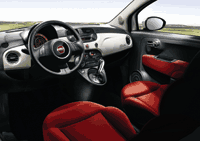WEB EXCLUSIVE: TPOs help Fiat 500 win Car of the Year
June 1, 2008
|
Automakers continue to search for the lightest-weight, highest-performing materials that will also enable them to innovate and differentiate their vehicles. Fiat (Turin, Italy) is no exception. In fact, the Fiat 500 won the 2008 Car of the Year award (juried by European journalists) in part because Fiat used two innovative PP-based TPO materials developed by Borealis (Vienna, Austria).
First, Fiat designers agreed that visual appeal was one of the top priorities for its new 500 model for both interior and exterior components. Its eye-catching design includes a large bumper with outstanding scratch resistance, a Class A smooth surface finish, and good paintability. Fiat invited Borealis to work closely with both its design team and bumper molding supplier Ersi Poland (Sosnowiec, Poland) to find the ideal material.
As a result, Borealis chose Daplen EE103AE, a high melt-flow-rate TPO said to have excellent scratch resistance and the ability to achieve uniform thickness over a large surface area. Company sources say its low thermal expansion over a broad temperature range ensures consistent high quality for large, molded parts, ensuring a precise fit to other exterior panels for a better overall visual impression.
Instrument panel specifications set by Fiat were particularly challenging, according to Borealis. “To keep a high level of aesthetic surface appeal and avoid visual defects, Fiat specified a mono-material solution for the 500's major interior parts,” says Franz Zängerl, manager business development automotive at Borealis. “Automotive molder Plastal, also located in Poland, chose Daplen EE168AI to meet requirements for excellent scratch resistance and low gloss, while also guaranteeing a consistent finish and high quality parts integration through the material's high dimensional stability and low thermal expansion.”
The Fiat 500 falls within the European Union's CO2 emission standard of 120g/km set to take effect in 2012. One of the reasons Fiat sought a TPO solution was because it would take weight out without reducing performance, and a lighter weight vehicle emits less CO2. Fiat declined to specify how much weight was saved by using polypropylene versus traditional ABS or PC/ABS in the interior.
“Vehicle manufacturers are continuously seeking ways to sharpen the competitive edge of their brands,” says Zängerl. “The use of Daplen materials in both interior and exterior applications on the 500 has helped Fiat to achieve its goals of producing a small vehicle with cutting-edge design features that will boost consumer perceptions of the entire company's image and quality.”
About the Author(s)
You May Also Like



